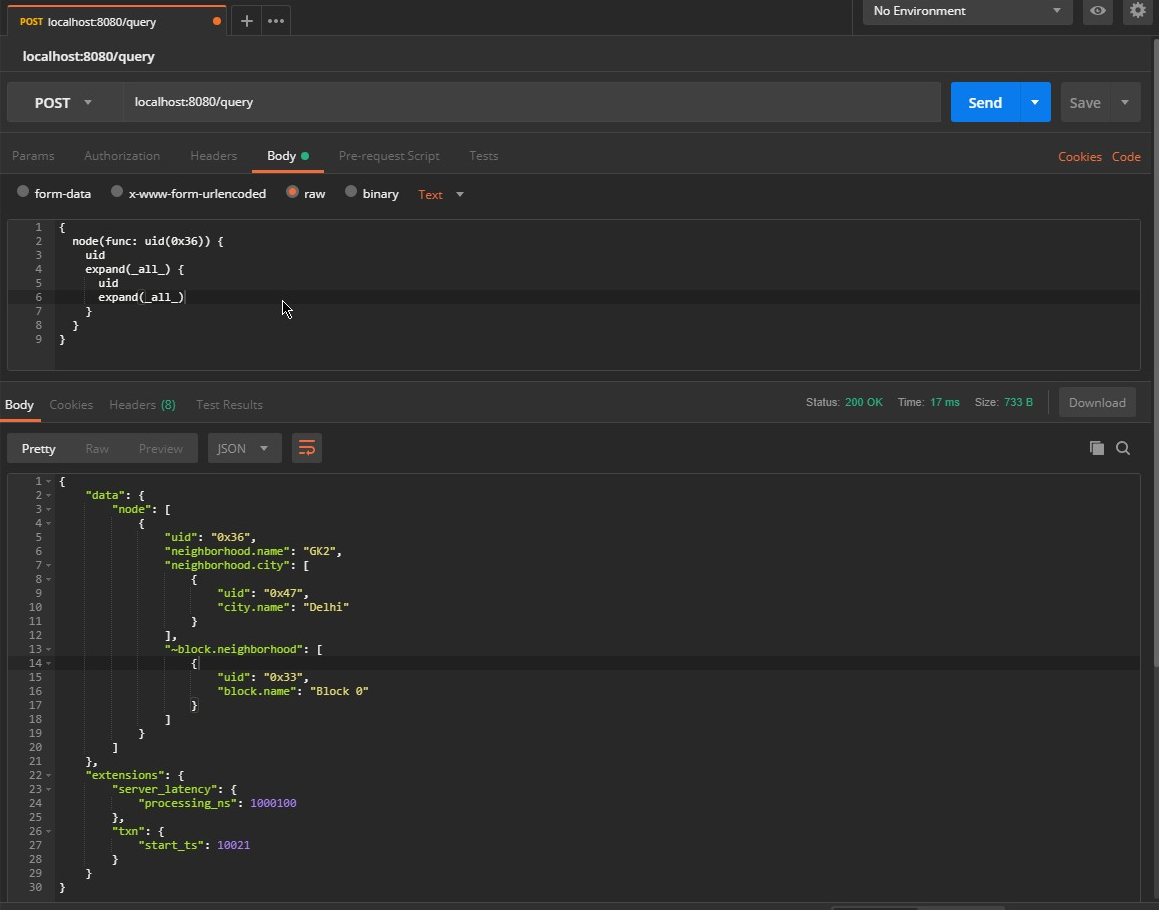Apollo-link-rest: A Possible support for Dgraph through Raw HTTP endpoint
This would be like a mix of GraphQL with GraphQL + - from Dgraph. However, if we could inject the Dgraph Query as we do in cURL. Dgraph would be fully compatible with Apollo.
curl -X POST -H 'X-Dgraph-LinRead: {"1": 12}' localhost:8080/query -d $'
{
balances(func: anyofterms(name, "Alice Bob")) {
uid
name
balance
}
}' | jq
More info in: https://docs.dgraph.io/clients/#raw-http
e.g;
const query = gql`
query Dgraph {
apartments@rest(type: "query", path: "query", endpoint: "DgraphEnd") {
bhk
uid
}
}
`;
``JS
const query = gql
query Dgraph {
apartments(func: eq(neighborhood.name, "Lutyens")) @rest(type: "query", path: "query", endpoint: "DgraphEnd") {
bhk
uid
}
}
`;
Mutation example:
```bash
curl -X POST localhost:8080/mutate -H 'X-Dgraph-MutationType: json' -H 'X-Dgraph-CommitNow: true' -d $'
{
"set": [
{"name": "Alice"},
{"name": "Bob"}
]
}' | jq
Cheers.
All 7 comments
I've find out that we can pass the Dgraph Query through the "Raw body" in Postman. So that's an sign that maybe possible Dgraph work with apollo-link-rest
PS. I think that the "bodyBuilder: $customBuilder" may be the way. But I'm not sure how it works.

BTW you can test against https://play.dgraph.io/query
just point the Postman to that endpoint, set "POST" and in Body set RAW and paste the Query below.
Pay attention that the UID may change in the future
{
node(func: uid(0x36bb9)) {
uid
expand(_all_) {
uid
expand(_all_)
}
}
}
This sounds like a big project. -- I don't think the hard part is using apollo-link-rest -- as you said, it's basically using the customBodyBuilder, or using a customFetch implementation. -- I think the hard part is going to be to "generate" the correct Dgraph-compatible payloads.
Please let us know what you figure out -- but it sounds to me like you'll need to make a pretty extensive "Query-Generator" that would be used as a customFetch implementation.
Dgraph is a database that has its language inspired by GraphQL. It's called "GraphQL + -". It is a DB graph with a graph language. However, there are many features that do not exist in GraphQL, but are still compatible. And indeed it's a big project.
I think we can work on Dgraph to support apollo-link-rest, but I wanted to understand if I can already do something with what's available (Like a "Hack"). I did not find any customizable examples that could send the "Body" as I exemplified using Postman.
Injecting the Body with RAW text would be an easy way to make Dgraph work with apollo-link-rest. Cuz the response is in JSON. There's no secret.
Looking at this Apollo project I see great potential with Dgraph.
Cheers.
@MichelDiz -- if that's the case, it almost looks like you might want to fork apollo-link-rest, and make apollo-link-dgraph
Possibly the best fix might be to fork apollo-link-http ? -- that layer speaks GraphQL, so generating GraphQL-like output from GraphQL might be easiest?
Not sure about apollo-link-http, cuz Dgraph GraphQL+- isn't compatible with graphql-tag tho.
I had tried before without success hit Apollo link with Dgraph's endpoint, and the request body is different. While /graphql accepts the query in "query key" Dgraph does not have a "Query" field, just a RAW one. But I think this can be evaluated. I'm not Dgraph's dev (go lang), but I'm talking about this situation with the team.
So the main differences are the graphql-tag and the position of the query payload. As apollo-link-rest also uses graphql-tag, I thought of creating a @'directive to inject the Dgraph query (as body) and use GraphQL too. Just like you do in "path:". But this is just speculation. The idea is still premature.
e.g:
const dgraphQ = `
{
users (func: has(user), first:1000 ) {
id : uid
name
email
}
}
`;
const query = gql`
query dgraphTest(
$customBuilder: any
) {
users @rest(type: "User ", bodyBuilder: $customBuilder, method: "POST") {
#Maybe bodyKey?? I'll test it
id
name
email
}
}
`;
apolloClient.query({
query: Query,
variables: {
input: { customBuilder: dgraphQ }
}
}).then(response => {
console.log(response);
});
Below is the difference between Dgraph's and GraphQL's request body.
GraphQL
POST /graphql HTTP/1.1
Host: api.githunt.com
Content-Type: application/x-www-form-urlencoded
cache-control: no-cache
Postman-Token: xxxxx
query=%7B%0A++++feed+(type%3A+NEW%2C+limit%3A+5)+%7B%0A++++++repository+%7B%0A++++++++owner+%7B+login+%7D%0A++++++++name%0A++++++%7D%0A%0A++++++postedBy+%7B+login+%7D%0A++++%7D%0A++%7D%0A++
Dgraph's GraphQL+-
POST /query HTTP/1.1
Host: play.dgraph.io
Content-Type: application/x-www-form-urlencoded
cache-control: no-cache
Postman-Token: xxxxx
{
node(func: uid(0x36bb9)) {
uid
expand(_all_) {
uid
expand(_all_)
}
}
}------WebKitFormBoundary7MA4YWxkTrZu0gW--
Going directly to DGraph from the client seems like a challenge, and one which may not leave room for concepts like authorization or business logic. Not that it wouldn't have utility, for sure--a link like you describe would be great for creating a client which easily explores a public graph directly.
I'm interested in using DGraph as the primary datastore for a consumer app, so I'm taking a different approach and trying to make it super easy to interface a standard Apollo Server app to a DGraph backend by converting incoming GraphQL queries into DGraph queries using a custom AST (inspired by projects like join-monster). I'm still kind of whiteboarding the idea in my free time, though, so no promises on delivery.
https://github.com/a-type/dgraphql
Perhaps any query conversion layer which I create could be portable to the clientside too, such that it could be extracted into a reusable library which a hypothetical apollo-link-dgraph could also utilize. Currently, though, I rely pretty heavily on being able to read the schema itself to generate that AST.